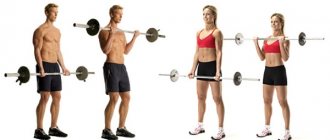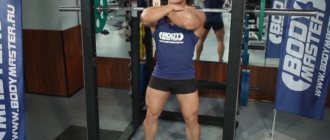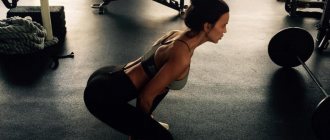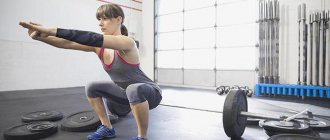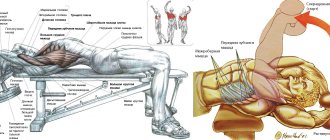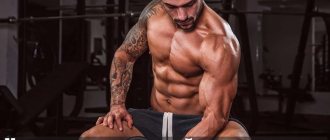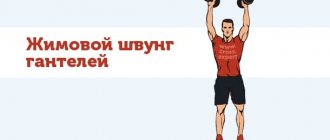Content
- 1 Barbell squats
- 2 Different types of squats
- 3 Muscles involved
- 4 When to stop bending in a squat?
- 5 Mythology of the squat
- 6 Amplitude and result
- 7 Squat technique
- 8 Examples of squat training
- 9 Front squat 9.1 Examples of front squat training
- 10.1 Tips and common mistakes
- 12.1 Front squats are less dangerous
Different types of squats[edit | edit code]
Source: “Cross-training”
Author:
instructor O.B. Derval, 2020
For simplicity , half squat
contrasted
with a full squat
.
But a deeper discussion reveals that in reality the full squat is opposed to all other types of squats. To make matters worse, it turns out that most of the trainers who extol the half squat are actually practicing... quarter squats. As a result, while in theory half squats collide with full squats, in practice we are talking about 1/4 squats as opposed to full squats. But a squat is a continuous movement that can be performed at different angles. To make sure we're speaking the same language, here's a classification of the different types of squats and definitions that leave no room for interpretation. Partial squats. Deep squats
- Full squats
: the athlete goes as low as his joint mobility allows without reaching the point of backward tilt of the pelvis. He squats so that his hamstrings touch his calf muscles. - Deep squats
: The athlete squats so that their thigh bones are at least parallel to the floor (parallel squat) - if not deeper. - Half squats
: any bending of the leg between a right angle at the knee and a horizontal position of the thigh bones. - Partial Squats
: Any squat where the knee angle does not reach 90°. These four types of squats involve different types of force and adaptation, and learning to differentiate them will further clarify the debate.
Squat
Squat
- a real “killer” of the quadriceps.
But don't forget that the glutes and, to a lesser extent, the hamstrings are also involved! Squat
Muscles involved[edit | edit code]
Squats with a barbell on your shoulders
– one of the most effective strength exercises in terms of gaining muscle mass. The movement is multi-joint and involves a large number of large and small muscles. Almost all the muscles of the lower body are involved when performing a squat with a barbell. Different movement options shift the emphasis of the load on different muscle groups. Squats, whatever their form, “recruit” more than 250 muscles. These are mainly the quadriceps femoris (lateralis vastus, rectus femoris, vastus intermedius and vastus medialis), gluteal muscles (minimum, medius and major, fascia lata and its tensor), as well as the back muscles. The muscles of the back of the thigh (semitendinosus, semimembranosus, and biceps femoris) act as fixators and stabilizers, and other leg muscles also participate in this (gemini, soleus, tibialis anterior, extensor digitorum, peroneus brevis and longus, gastrocnemius). Let's not forget the critical role of the lumbar back stabilization and the abdominal plank.
- Thigh and leg muscles
- Muscles involved
- Squats
What muscles work in barbell squats?
The exercise works the following muscles:
- The gluteus maximus, medius and minimus muscles, as well as the fascia lata.
- Quadriceps femoris (rectus femoris, vastus internus, vastus externus, vastus medialis).
- Biceps femoris muscle.
- Semitendinosus muscle.
- Semimembranosus muscle.
- Iliotibial muscle.
Stabilizing muscles are: the muscles of the back and lower back, chest, abdomen, trapezius and deltoid muscles.
To a lesser extent, the following muscles are involved: gemellius, soleus, tibialis anterior.
When to stop bending in a squat?[edit | edit code]
Deep Forward Bend as a Universal Squat Rest Position
No matter which way we approach the squat problem - whether it's about safety or performance - the main point of debate is always its completeness. And the main question often remains, rather, “where to stop the bending” than “how much to put on the bar.”
An anatomical observation immediately comes to mind: the human body is designed (and even “optimized”) for squatting. To the point that entire civilizations chose such deep bending as a resting position
.
Let's explain:
For healthy knees, ankles or hips, there is no contraindication to full flexion. In 2001, Salem and Powers confirmed to us that there was no difference in knee load between a full, half, and quarter squat.
Things get more complicated when the external vertical load increases (or even internal when it comes to working with body weight). In this case, two problems may arise that require monitoring:
Axial pressure
, produced by the load on the spine - in particular, on the intervertebral discs. The human body is designed to squat, but not with three times its body weight. If maximal loading is part of the progressive progression phases, there are other methods for intensifying the work—and they don't necessarily involve systematically putting incredible amounts of weight on the bar.
Pelvic position
, which can bend back at different angles in different people, causing rounding of the entire spine. Given the preventative nature of cross-training, pelvic malposition is unacceptable and should therefore never occur. As long as the natural lumbar lordosis is maintained and the knees follow the direction of the toes, deep flexion is not a problem. The question of eliminating deep squats altogether is therefore completely far-fetched. The limits of flexion vary strictly individually and are determined by the moment when the athlete no longer controls his hips and the trajectory of his knees.
Setting the objectives of the training system
When setting out on the path of conquering the stubborn muscle group in the buttocks area, it is necessary to determine the target result of the training process.
For one category of girls this is a correction of shape, for another it is an increase in muscle mass, and still others dream of their butt acquiring a less respectable size. Therefore, to build training with a high degree of effectiveness you need:
- identify baseline indicators;
- determine the desired end result;
- choose a way to achieve the goal of the training process.
If the pursued goal of women's training is to reduce the volume of the buttocks, then all exercises to work out the muscle group must be done at a high-intensity pace, in addition, the rest interval between approaches should be short. Working weight in this type of training is not critical. It is selected taking into account the ability to produce and productively perform a given number of times in an approach.
Training should be structured completely differently for those girls who want to increase the muscle mass of their buttocks . The intensity of the training should be low, the weight should be impressive, and the rest time between approaches should be long. The need for a long rest is due to the fact that the nervous system responds very powerfully to strength training; it takes about 5 minutes to restore it. In a shorter period, the nervous system will not be able to recover, and this will affect the effectiveness of the exercise performed.
Girls who see a decrease in fat mass and an increase in muscle mass as the end result should alternate their workouts. They can include two high-intensity workouts with light weights and one low-intensity workout with heavy weights in their weekly training program.
Mythology of the squat[edit | edit code]
Behind all the semantic and anatomical considerations that shed light on this debate, collective "beliefs" have formed around the depth of the squat, which becomes increasingly dangerous as it increases. Numerous teams of scientists have decided to put this debate through the filter of experiments. And to date, no study has shown that full squats have a higher risk of injury and less performance than half squats.
Despite this, many trainers and their students believe that systematically performed partial squats are less dangerous than full squats. And the less we go down, the more we can load the bar. But thus, the progress in half squats is to strip Jacques to dress Jean: what we save in knee work is transferred in the form of vertical pressure on the spine... for a result that is not necessarily higher. Indeed, Bryanton and his collaborators found in late 2012 that progress in the squat was more related to amplitude than load.
Amplitude and result[edit | edit code]
Still, the effectiveness of the half-squat remains questionable. First of all, as V. Zatsiorsky reminded of this throughout his career, as well as in his recent work “The Science and Practice of Strength Training,” few physical actions are performed with full amplitude.
Additionally, strength gains are optimized for certain types of work. For example, we manage to achieve specific load redistributions already in the first degrees of leg flexion, even if the work is limited to partial amplitude. (Massey et al 2005). Although more and more studies show that the result depends on the entire movement as a whole.
Finally, the use of overload, while reducing neural inhibition, as suggested by Wilson in 1994, appears to be capable of improving half squat performance. This argument, however, faces risks associated with higher stress on the spine).
Thus, it is clear that partial squat work should retain a significant, but not exclusive, place in the training program.
As for deep squats, Bryanton's 2012 study proved that they not only significantly increase muscle work compared to partial squats, but also demonstrated that the quadriceps muscles are especially sensitive to the depth of the squat, and the gluteal and leg muscles are activated even more when performing deep squats. using heavy loads. The study therefore clarifies that the effect on vertical extension will be more noticeable the deeper and heavier the squat. Of course, activation of the posterior muscles during deep and especially heavy squats also plays a significant role in the enhanced effect of full squats on lower extremity extension and explosiveness.
These two exercises, so similar in appearance, actually do not involve the same muscle groups. Accurate electromyographic analysis of various aspects of squatting performance, such as that performed by Signoril in 1994, or muscle force measurements carried out by Bryanton in 2012, gives us precise information about the participation of different parts of the body in different types of squats.
Squatting deeply is not at all dangerous - on the contrary, it increases your results without increasing the weight of the barbell.
Remember the following:
- By increasing the depth of the squat without necessarily changing the load,
the muscle force of the knee extensors increases, the force of the ankle extensors decreases, and the activity of the anterior rectus femoris, spinal muscles and biceps femoris increases, - As the depth of the squat decreases with increasing load,
the muscle force of the ankle extensor muscles and the activity of the gastrocnemius muscle increase; - As the weight and depth of the squat increases,
the muscle force of the hip flexors increases.
Squat technique[edit | edit code]
The squat, full or partial, is a very technical exercise where safety and effectiveness are ensured, first of all, by impeccable technique. Neglecting technical precision exposes the cross-trainer to the risk of injury and lack of progress, which almost always results in failure of all or part of the training program.
- Grip width on the bar
: The hands, located slightly wider than the shoulders, hold the bar and are positioned as if pressing the accelerator of a motorcycle. The thumbs hold the bar in the lock; palms, wrists and forearms are aligned in one line. Elbows slightly back and pointing down.
- Barbell supine position
: The barbell rests on the back of the trapezius muscles, with the shoulder blades retracted to form a perfect “rest” on the back of the deltoid muscle.
- Foot position
: may vary, but is always identical on both sides. We advise you to take a comfortable and symmetrical position.
- Removing the bar from the rack
: Before removal, the bar is on the rack, slightly below the shoulder line, when the athlete is standing nearby.
- Removing the bar
: is done by lifting from a squat underneath it, while the athlete maintains a full bar. Once the bar is removed, you need to take a step back, staying close to the bar.
- Head position
: the head continues the line of the spine, the athlete fixes the direction of his gaze straight ahead.
- Leg Curl
: Squeeze your knees and hips at the same time to slightly lower your center of gravity. Keep your stomach flat without arching your lower back too much. Lower the hip joint to a certain level, depending on the type of squat you choose - full or partial. The knees are in the same plane as the hips and feet. The heels rest on the floor.
- Leg straightening
: Extension of the knees, hips and torso should occur synchronously, avoiding knees. Standing up should be symmetrical and without stopping.
- Critical moment
: When the femur and tibia form a right angle, muscle tension reaches its maximum. At this moment the line of movement should be perfect.
- Speed of execution
: There are many techniques. In general, the descent should be controlled, and the search for speed of execution occurs mainly during the ascent.
- Breathing
: inhale at the beginning of the bend, then exhale sharply at the end of the straightening. Throughout the entire exercise, the trainer will pay double attention to the position of the back and control the anterior tilt of the pelvis, which guarantees the preservation of natural curves (rounding the back is unacceptable and should lead to a change in those responsible for the “purity of execution”).
Final Cautions
And yet, despite all these potentially productive and injury-preventive technical results, the squat's historical detractors are not necessarily completely wrong. Under the guise of being concerned with efficiency, some cross-training trainers can sometimes forget the absolute caution they must exercise at all times, the age of the trainee being a primary consideration. The young public should be trained to achieve results, not to demonstrate them. Work on squats for young people, of course, has not been cancelled. This is work on technique. More and more cross-trainers are starting with cross-training without any technical background, so there is no need to rush into teaching.
Finally, training in heavy squats, both deep and partial, should not begin until sufficient plank levels and lower (and upper) limb strength have been achieved. Thus, the wisest thing to do during the initial period would be to build a strong foundation for a healthy and effective practice. squats for many years
.
The student will have to go through a “technical filter” in parallel with the analytical and methodical strengthening of his body.
Types of squats with a barbell and technique of execution
The classic version of squats with a barbell for girls is the version with the legs positioned at shoulder level, while the barbell (or dobidar) is located on the back - on the lower part of the trapezius muscles. This universal position, which allows you to work out a maximum of muscles without focusing on a specific group, is also considered the safest7.
Technique for performing classic squats:
- – Approach the barbell located on the racks and, slightly bending your knees, “dive” under it so that the barbell is on the trapezius. Take a stable position, straighten your knees, remove the bar from the racks, and take a step back.
- – Having taken the starting position, begin bending your knees until your buttocks are at knee level or below. The spine does not bend, the gaze is straight ahead, the head and neck are motionless. During a squat, the knees do not go beyond the line of the toes (the shoulders are on the same line or close to it at the lowest point), the buttocks are pulled back as much as possible.
- – Once the buttocks have reached the lowest point (knee angle 90 degrees or less), return to the starting position with the knees fully straightened. The squat is then performed again and after completing a certain number of repetitions, the barbell is returned to the racks.
- – During the exercise, your feet touch the floor firmly; shifting your weight to your toes or heels is unacceptable. Toes and knees point in the same direction - they are slightly turned to the sides to increase stabilization of the position. The squat itself is performed while inhaling, returning to the starting position while exhaling.
The location of the bar on the back is variable - the bar can be placed lower or higher, which also affects the distribution of the load in the lower body. Squats with a barbell for girls should definitely start with a minimum weight; it is optimal to use a body bar. Until you fully master the technique, it is recommended to practice under the supervision of a professional trainer.
Basic mistakes during squats:
- – rounding of the back (risk of spinal injury);
- – reduction of the knees (danger of injury to the knee joint);
- – heel lifting, rolling from heel to toe (danger of losing balance).
Contrary to popular belief, putting your knees behind your toes is not a mistake and does not create a critical danger. This is a natural physiological movement, and the further forward the knees move, the higher the load on the joints. It is important to perform movements in an amplitude that is comfortable for the body, and there is nothing wrong with the knees going beyond the toes14.
Examples of squat training[edit | edit code]
Workout 1 – full body push
- 5 x 3 pushes, recovery 2 minutes. as many times as possible in 12 minutes:
- 5 squats - 5 bench presses at your maximum for 12 reps.
Workout 2 - Explosive Squats
- 5 X 3 snatches, recovery 2 minutes.
- minute start for 10 minutes;
- 1 full squat at your maximum for 4-5 reps, then 60m sprint.
Workout 3 - Functional Hypertrophy
- 5 dips at maximum - 10 sec. recovery - 5 jumps with maximum extension - 2 minutes recovery - 6 pistol squats on each leg. 5 sets, with 2 minutes recovery.
Finish with as many air squats as possible in 2 minutes.
So, the cross-training technique, in its best traditions, recommends alternating squats, giving preference to deep squats. The best study that leads us to this principle of alternation is the work of Drinkwater et al. (2012), which examines the differences between the effects of heavy (5 reps x 83%) and light (10 reps x 67%) training, with partial or deep squats.
This time the analysis is based on different strength parameters.
Here's what to remember from this:
| Heavy load, deep flexion | Light load, deep flexion | Heavy load, incomplete flexion | Light load, partial flexion | |
| power | + | + + | +++ | — |
| force | ++ | + + + | + + + | — |
| peak speed | ++ | + + + | — | + |
| Job | +++ | — | + | + + |
The answers in terms of both safety and results should be found in the technical quality of the execution - depending on your goals,
Front squats[edit | edit code]
Front Squats
The front squat is the safest alternative to the traditional barbell squat.
It is also one of the educational methods that comes from weightlifting, and it goes well with technical or semi-technical exercises, such as various types of barbell cleans or snatches.
This type of squat, compared to the traditional barbell squat, has also been proven to reduce inter-articular tension in the knee by 15% without loss of muscle activity.
The lightest loads in CrossFit help limit the risks of loss of balance or loss of body position inherent in this technique in other strength disciplines. Front squats are characterized by:
- very good stimulation of the quadriceps;
- easier back alignment;
- excellent neuromuscular activation even with light exercise; *allows flexible achievement of results.
This form of squatting is still very technical and even though we strongly recommend it, it may be daunting for some people who are simply not used to doing it and/or have stiffness in their ankles or shoulders that limits movement.
In this case, for immediate effectiveness and greater comfort during performance, choose the classic barbell squat. If, on the other hand, you are looking to improve your flexibility and your weightlifting movements, then take the time to introduce this type of squat into your TDs.
Exercise technique
“The rules are the same as for the back squat. The only difference is the position of the barbell on your chest: to hold it in place, you need to raise your elbows as much as possible (ideally, your shoulder bones should be parallel to the floor).
If you are looking to improve your mobility and flexibility while continuing to build strength, then these squats are for you.
Goblet Squat Variation (Goblet Squat)
This type of squat can be performed either with dumbbells or with a kettlebell pressed to the chest. In this case it is called "Squat Goblet"
. Goblet Squats are especially recommended for long series.
Examples of front squat training[edit | edit code]
Workout 1 - Maximum Strength Endurance
- 3 x 5 front squats -3 minutes max recovery
- 10 x 1 front squats - 1 minute max recovery
Workout 2 - Fatal Countdown
Perform in combination - front squats - box jumps - bending (closing) the torso on the bar
10, then 9, then 8, 7,6,5,4,3,2,1 repetitions.
Workout 3 - Double Relaxation
- 4×3 barbell cleans
As many times as possible in 5 minutes: 6 front squats - 12 pull-ups. 2 approaches. 2 minutes recovery
Anyone can do a barbell squat correctly.
The standards for this movement differ between powerlifting and bodybuilding. The peculiarity is that the lifter’s version is more anatomically determined:
- they go under the barbell with their stomach already retracted and their shoulder blades pulled towards the spine, the bar is set quite low, just below the midline passing through the rear delts;
- check your posture, gather yourself, remove the apparatus, step back, place it at a comfortable foot width in two steps and begin the exercise;
- the feet stand at a width that is comfortable for the hips and does not allow the kneecaps to move inward;
- the bar lies low, which eliminates the separation of the shoulder blades and loss of stability, usually accompanied by a back injury;
- toes are moderately spread to the sides, adding stability to the pose;
- the movement begins with the pelvis down and back, accordingly the knees bend. This squat is similar to how we usually sit on a low bench;
- throughout the entire movement, the abs are pulled in, the back is in a natural arch, the forward bend is very moderate, the body does not rest on the hips;
- at the point of maximum depth, the lumbar region does not “unwind”, and the pelvis does not make the characteristic “peck” downward. Sometimes a squat with this movement is allowed, but not for beginners training for aesthetics. “Pecks” and “kicks” due to bending the legs can occur during power squats, with small jumps; they are not used in health fitness;
- This is followed by a smooth lifting of the weight due to extension in the hip and knee joint.
Individual squat technique involves determining the available depth and maximum forward lean. Stand in profile to the mirror and sit down. As soon as you notice that the lumbar region “unwinds” and the pelvis “pecks” - you have reached the maximum depth, fixate on it, there is no need to force it any further.
The slope should be the same as what you get if you sit with your knees on the wall with your toes at a distance of 10-15 cm from its surface. There is no need to lower your chest any lower. Well, the spacing of the feet and the distance between the knees is selected so that there is no transfer of body weight to the toes, and various vibrations of the hips (their opening and spreading).
It is best to learn the barbell squat technique from a trainer. Independent exercises are also good and will come in handy, but only after you automatically correctly take the weight from the racks, gather yourself, and smoothly perform both lowering and lifting the weight. Most gyms offer some personal training, which will help.
A coach is also needed to determine what additional exercises will help you get rid of bad squatting habits. Such habits are developed by the way we walk and sit from childhood, and can be very harmful when we gain weight. Don't want to squat with a lot of weight? Strength training should be progressive. You cannot achieve results by training with an empty bar your entire life. Typically, girls who train reach one and a half body weights on a barbell in a year or two of training in the “three workouts per week” format, and this is not a record, but a completely typical indicator.
Squatting technique with a barbell on the shoulders (video)[edit | edit code]
Squats. Peculiarities
- Stand facing the bar between the racks of a power rack. Stand with the bar resting on your trapezius muscles.
- Grab the bar with an overhand grip slightly wider than shoulder-width apart and stand straight up.
- Starting position: Step back a little with the barbell. Place your feet shoulder-width apart and point your toes slightly to the sides. The back and legs are straight. The weight of the barbell is completely equally distributed on both legs.
- Take a deep breath and, holding your breath, slowly lower down. The knees bend and move forward slightly, the buttocks move back and down, and the body leans forward, up to 45° relative to the vertical.
- Don't slouch
- Keep your heels off the floor and your gaze directed forward.
- Once your thighs are parallel to the floor, still holding your breath, tighten your thigh muscles and rise up to the starting position.
- Start exhaling after you overcome the most difficult part of the climb. Continue exhaling until you return to the starting position.
For a more accurate barbell squat technique, watch the video.
Barbell squat technique
Tips and common mistakes[edit | edit code]
If you have flat feet of any degree, it is highly recommended to use orthopedic insoles with an instep support that has sufficient rigidity. Otherwise, during such heavy exercises, the load is absorbed by the knee joints, which is fraught with the development of arthrosis.
- For safety, always keep your back slightly arched at the waist. Do not relax your psoas muscles until you lower the barbell onto the supports. Rounding your back increases the risk of injury and reduces the effectiveness of the exercise.
- Keep your abdominal muscles tight throughout the set. This makes it much easier to hold the body in a stable position and prevent it from swaying. However, do not overdo it: by straining your abs too much, you will involuntarily begin to round your back.
- When squatting and straightening up, never lift your heels off the floor. Squatting on your toes (rather than on your feet) can cause you to lose your balance and risk injuring your knee joint (it will move too far forward). At the lowest point, the knees should not “crawl out” beyond the line of the toes.
- The depth of a barbell squat (the bottom point of the exercise) is determined solely by how far you can arch your spine without lifting your heels off the floor during the squat. *If you feel your back begin to slouch and your heels lift off the floor, do not squat deeper.
- If the distance between the feet is too narrow, then the maximum load will fall on the quadriceps and they will be involved much more than the muscles of the back of the thigh. But such a position of the legs requires great mobility of the hip and ankle joints. If your feet are wider than your shoulders, you can squat with heavier weights without worrying about hip flexibility. However, in this case, the main load will be taken by the muscles of the back of the thigh, and not the quadriceps.
- Barbell squats (variations)
- Barbell squats (variations)
- Barbell squats (variations)
- Barbell squats (variations)
The general effect of squats with a barbell on the shoulders[edit | edit code]
Squats with a barbell on your shoulders
, along with deadlifts, create the best conditions for gaining strength and muscle mass throughout the body. In this case, the greatest load falls on the muscles of the legs and lower back. In addition, squats are used as a general strengthening and rehabilitation exercise.
Squats and age[edit | edit code]
Due to the powerful effects squats have on the human body, older athletes take extra precautions. For older people, warm-up, cleanliness of the exercise and compliance with safety precautions are more important. Research shows that doing squats in old age brings no less benefits to the body than doing squats in young athletes, and recovery from injuries occurs in approximately the same time with the right recovery course. In powerlifting, competitions between veterans are regularly held (both in triathlon and separately in squats).
Equipment
Even with proper squatting technique, a lot of pressure is placed on the lower back and joints in the knees. If you do not provide additional protection for ligaments and joints with the help of sports accessories, injury cannot be avoided.
| Part of the body | Protection | Note |
| Small of the back | Weightlifting belt | If the load is particularly heavy, it is recommended to use limiter pins, which are placed at waist level and do not allow a squat lower. This sports accessory prevents unnecessary stress on your back. |
| Knees | Elastic bandages | If you need to work out the muscles of the legs and buttocks well, but do not overload the knee joints, you can use the Hack machine. This machine allows you to load different muscles, change the position of the lower limbs and not put excessive pressure on the knees. |
| Ankles | Barbells with heels | Such special shoes will help to properly distribute the load, not lift your heels off the floor and not transfer the weight of your body or barbell onto your toes, which can lead to ankle injury. |
| Feet | Rigid orthopedic insoles with instep supports | Will help avoid flat feet and arthrosis. |
| Hands | Carpal loops | Strengthen your grip. Helps hold the barbell during Hackenschmidt squats. |
Back squat records[edit | edit code]
Typically, you can lift slightly less weight with a squat than with a deadlift (more with special equipment). Squat records are recorded by various powerlifting organizations. Due to the fact that the rules regarding squat technique and doping differ in different versions, the squat records also differ from each other. The absolute world record in the equipment version (IPA) belongs to the Israeli athlete Vlad Alkhazov and is 567 kg; in the IPF - the only federation recognized by the sports committees of most states and negotiating with the IOC on the inclusion of powerlifting in the program of the Summer Olympic Games - the absolute record in squats is 457.5 kg. and belongs to the American Shane Hamman;
On October 17, 2020, Ray Williams set a new record in the bare squat - 456 kg.
Types of squats
Squats for 30 days are a great way to tighten the muscles of your thighs and buttocks. They help improve blood circulation, break up unsightly cellulite, have a beneficial effect on health and stamina, and make muscles healthy, strong and elastic. This is also a simple exercise, for which we do not need either specialized equipment or a large amount of space, it burns fat remarkably, improves coordination of movements, and has a beneficial effect on the functioning of the heart and blood vessels, and metabolism.
For a person of average height and build, five minutes of squats is an opportunity to burn about 43 kcal . For people with more weight, the number of calories increases. You can perform the exercise on one or two legs, with or without weights. In general, it has a lot of variations, and for better effectiveness, it is desirable that the 30-day set of squats for buttocks includes different versions of squats. Let's look at some variations.
Basic squat
You need to stand on the floor, place your feet shoulder-width apart. Then squat until you are parallel to the floor, as if you were trying to sit on a low bench. While performing the exercise, keep your back straight, do not round it or bend forward.
Beginners are recommended to start squatting in front of a mirror. This will help you control the technique of performing the exercise and correct errors immediately after you notice them.
Wide stance squat
Your legs should be placed slightly wider than shoulder level, and your feet should be turned out to the sides. The knees should be spread as wide as possible, lowering as you inhale at a slow pace and making several springy movements. Rise as you exhale. One variation of this exercise is the plie squat. They are considered very effective, and are especially popular among girls, so the 30-day squat chart may include them too.
Narrow stance squat
For this exercise you need to bring your feet together. Close your knees and place your hands on your hips. Inhaling, slowly lower yourself. As you exhale, rise up. To maintain balance, you can stretch your arms forward and tilt your body slightly. Remember to use a springy motion.
Squats with legs wide apart train the inner thigh better, while exercises in a narrow stance train the outer thigh.
In addition, you can add to the squat schedule for girls for 30 days various variations of the basic exercise , which will make it more difficult:
- On the way up, kick back.
- Crouching, lower your hands to the floor. When standing up, lift them above your head and draw them as if in a circle.
- Squat down with your hands behind your head. When standing up, pull your knee towards your elbow.
- As you rise from the squat, jump up.
- Lift one leg off the floor and lower yourself onto the other.
- Leave one leg back and sit down on the front one.
- Spread your legs to the sides in a jump, squat down.
For squats, you can use dumbbells or a barbell . Read all about the types of squats with dumbbells in hands for girls here. When you go down, the muscles in your buttocks and back are tense, and when you go up, your own weight will be a burden. Hands stretched forward, crossed over the shoulders or gathered at the waist will help you maintain your balance.
Squat not on your toes, but on your full foot. You should not hold your breath. When doing lunges, put your leg out as far as possible so that the gluteal muscles stretch more. To improve the effectiveness of the exercise and speed up the achievement of results, you can combine squats with abdominal exercises, push-ups, and cardio exercises. This will help both improve the shape of the buttocks and hips, and reduce the size of the waist and abdomen.
Before planning a squat regimen for girls for 30 days, be sure to make sure there are no contraindications. Among them are injuries to the knees, ankles, hip joints, and recent fractures in the lower body. You should not squat during pregnancy or if you have a lot of excess weight, as this increases the risk of knee injury.
Injuries[edit | edit code]
If safety precautions are not followed, if there is insufficient warming up before execution, or if the technique is not performed strictly, squats, especially with heavy weights, are a dangerous exercise that has a negative impact on the athlete’s knee joints and spine. Some studies conducted in the mid-20th century also indicate that squats strain the knee tendons, causing them to be removed from the physical training program of some US military units. However, more recent studies by the University of Alabama and other organizations have found no negative effects of the squat on the knee joints, when performed correctly, in either amateur or professional powerlifters.
It should be noted that excessive overload of the knees leads to wear and tear on the sliding cartilaginous surfaces of the joints, inflammation and unbearable pain, for which reason chondroprotectors can be used.
Front squats are less dangerous[edit | edit code]
A University of Florida research study[1] showed an 18% reduction in knee load in front squats compared to back squats. The scientists also noted that in both exercises, maximum muscle tension develops during the lifting stage. In terms of muscle tension and muscle involvement, virtually no difference was observed. Thus, if an athlete has no contraindications, then there is no reason to consider one type of squats more effective. However, for athletes with knee injuries, front squats are less dangerous, especially if they have problems with the shoulder girdle and cannot hold the barbell over their shoulders.
Back squats[edit | edit code]
Source:
“Bodybuilding.
Book trainer" .
Editor:
Oksana Usoltseva
Ed.
: Eksmo 2013.
Back squats (Step 1 and Step 2)
Equipment
:barbell.
Core muscles
: quadriceps.
Additional muscles
: buttocks, lower back, hamstrings.
Level of training
: beginner, intermediate.
Due to the shift in the center of gravity, the quadriceps receive more load. This exercise is not suitable for advanced athletes who lift heavy weights due to the inconvenience of holding a heavier barbell.
Step 1
. Hold the barbell with your arms extended behind your back, palms facing back. Feet shoulder width apart.
Step 2
. Slowly lower yourself as if you were about to sit in a chair. Keep your back in a natural position.
Step 3
. When your thighs are parallel to the floor, return to the starting position.
What kind of squats should I do?
Beginning athletes are faced with the problem of selecting exercises from a variety of squat options. We recommend starting with the classic ones - feet shoulder-width apart, back straight, pelvis lowered to a right angle at the knees or slightly lower. This technique allows you to use the quadriceps and buttocks - muscle groups responsible for the formation of beautiful legs.
To fully work out your lower body, you should combine different types of squats. For example, girls very often have the problem of sagging inner thighs. An effective exercise in this case would be a plie squat - the feet stand very wide, the toes are turned outward, the pelvis is lowered to a right angle at the knees. The element allows you to work the adductor muscles of the thigh.
There are also squats for the buttocks - curtsy. Briefly about the technique: the athlete takes a wide step back and places his toe on the floor; the foot of the abducted limb should be behind the line of the supporting leg; From this position, smooth squats are performed. The element specifically loads the gluteal muscles. To enhance the effect, we recommend using light dumbbells or weights.
Read also[edit | edit code]
- High rep squats
- Legs - exercises and training features
- Squats with a barbell for girls
- Squats with a barbell on your shoulders
- Wide-legged barbell squats
- Plie squat
- Front Squats
- Snatch squats
- Thrusters
- Single leg squats
- Pistol squats
- T-bar squats
- Forward bends with a barbell
- Bent-overs with a barbell on your shoulders
- Iron World 2011 No. 2 “Back squats” - p. 20.
- Muscle and Fitness 2011 No. 7 - p. 128.

